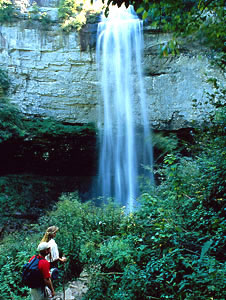
Fall Creek Falls State Park
Tennessee’s second largest park is Fall Creek Falls State Park, which covers a total of 19,684 acres. The park is located between Spencer and Pikeville along the border of Van Buren and Bledsoe Counties. Located near the upper Cane Creek Gulf watershed, the site utilizes severely eroded land that federal authorities purchased for less than seven dollars per acre. Despite the devastation, the park’s landscape was compelling, even overwhelming, in its rugged beauty in the fall, according to leading conservationists of the time. Initially, the National Park Service planned to purchase land that included both Cane Creek and Fall Creek watersheds, but finally limited its acquisition to approximately half the original proposal.
Park construction began in 1936 following the arrival of the Civilian Conservation Corps (CCC) and Works Progress Administration (WPA). The Resettlement Administration (RA) relocated families living in the area of development, the CCC restocked wildlife and began reforestation, and the WPA assisted with construction.
The State Forestry Service and Department of Agriculture administered the park throughout the 1930s and 1940s. The National Park Service oversaw development, which included the construction of parking areas, picnic and camping facilities, trails, shelters, scenic overlooks, a dam, a swimming pool, a lodge, and cabins. Although the park’s remote location made access difficult, the National Park Service encouraged visitation by accentuating the area’s multiple waterways, including the spectacular 250-foot Fall Creek Falls. In time, the multiple waterfalls secluded by cliffs and the backdrop of the Cumberland Mountains made Fall Creek Falls one of the state’s most popular parks.
Park development moved slowly in order to maintain the area’s “natural state.” In 1940 the Park Service permitted the construction of vacation cabins, a lodge, horse barns, and horse trails to encourage visitation, but abandoned the project because of World War II labor and funding demands. In 1944 the Department of the Interior transferred the park to the State of Tennessee, but restricted land to recreation and conservation. The Tennessee State Planning Commission resubmitted the National Park Service’s proposal of 1940 in 1950 and obtained state funding for the construction of recreational facilities. The park added swimming facilities in 1954, but eight years later the recreational area still included only two manmade camping areas and prohibited boating, emphasizing the area’s natural falls and scenery rather than its modern amenities.
Today, park attendance places Fall Creek Falls among the state’s most heavily visited recreational sites. The park currently offers a nationally rated public golf course, a modern inn and restaurant complex, as well as natural vistas that include the park’s namesake, Fall Creek Falls. Administrators have successfully retained the park’s most valuable resources, including Cane Creek Gulf, Cane Creek Falls, Rock House Creek Falls, Piney Falls, numerous gorges, natural foliage, and an abundance of wildlife species. The park remains, as the National Park Service remarked in the mid-1930s, “unquestionably one of the most outstanding beauty regions” in the eastern United States. (1)



